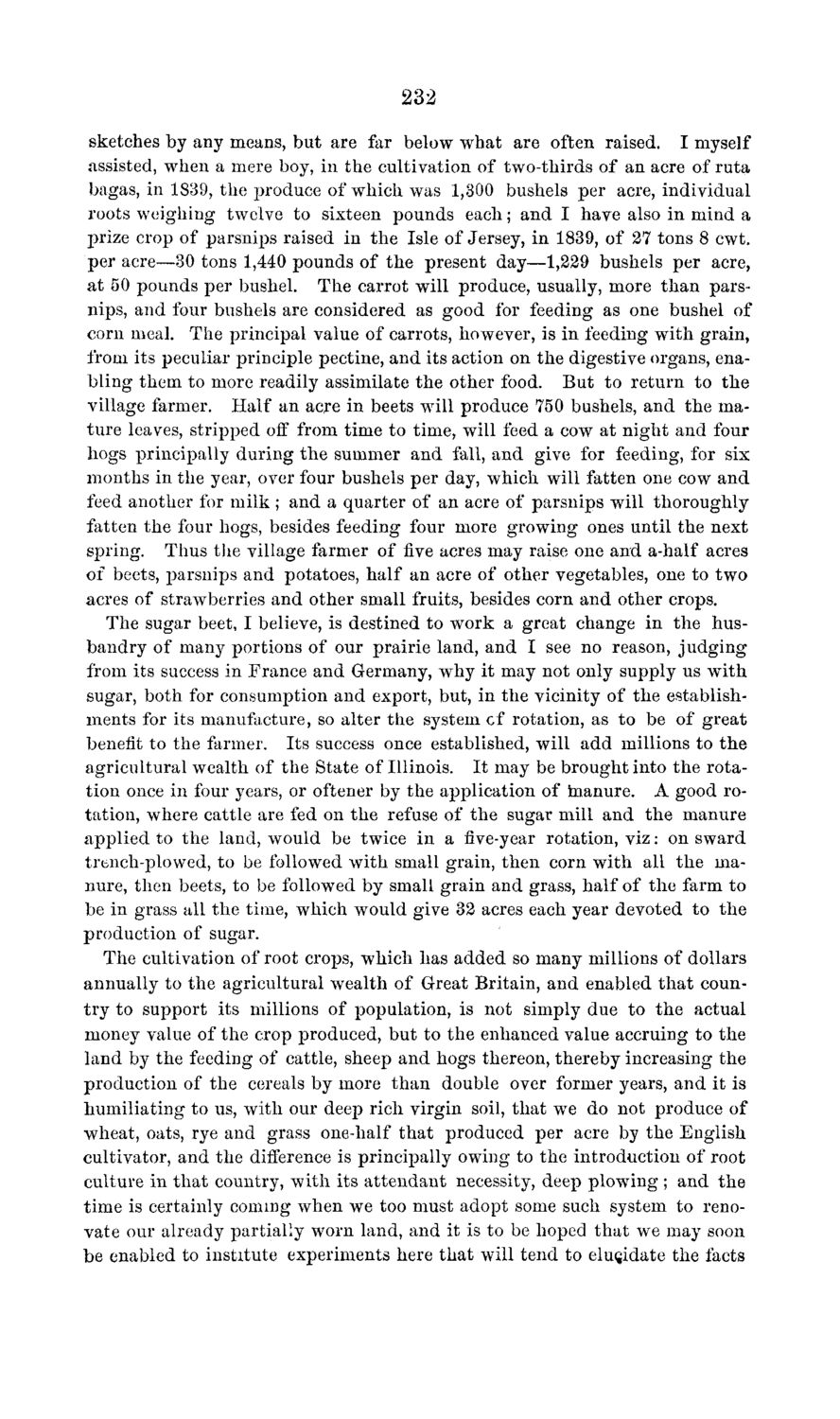| |
| |
Caption: Board of Trustees Minutes - 1869
This is a reduced-resolution page image for fast online browsing.

EXTRACTED TEXT FROM PAGE:
232 sketches by any means, but are far below wrhat are often raised. I myself assisted, when a mere boy, in the cultivation of two-thirds of an acre of ruta bagas, in 1839, the produce of which was 1,300 bushels per acre, individual roots weighing twelve to sixteen pounds each; and I have also in mind a prize crop of parsnips raised in the Isle of Jersey, in 1839, of 27 tons 8 cwt. per acre—30 tons 1,440 pounds of the present day—1,229 bushels per acre, at 50 pounds per bushel. The carrot will produce, usually, more than parsnips, and four bushels are considered as good for feeding as one bushel of corn meal. The principal value of carrots, however, is in feeding with grain, from its peculiar principle pectine, and its action on the digestive organs, enabling them to more readily assimilate the other food. But to return to the village farmer. Half an acre in beets will produce 750 bushels, and the mature leaves, stripped off from time to time, will feed a cow at night and four hogs principally during the summer and fall, and give for feeding, for six months in the year, over four bushels per day, which will fatten one cow and feed another for milk ; and a quarter of an acre of parsnips will thoroughly fatten the four hogs, besides feeding four more growing ones until the next spring. Thus the village farmer of five acres may raise one and a-half acres of beets, parsnips and potatoes, half an acre of other vegetables, one to two acres of strawberries and other small fruits, besides corn and other crops. The sugar beet, I believe, is destined to work a great change in the husbandry of many portions of our prairie land, and I see no reason, j u d g i n g from its success in France and Germany, why it may not only supply us with sugar, both for consumption and export, but, in the vicinity of the establishments for its manufacture, so alter the system cf rotation, as to be of great benefit to the farmer. Its success once established, will add millions to t h e agricultural wealth of the State of Illinois. It may be brought into the rotation once in four years, or oftener by the application of inanure. A good rotation, where cattle are fed on the refuse of the sugar mill and the manure applied to the land, would be twice in a five-year rotation, viz: on sward trench-plowed, to be followed with small grain, then corn with all the manure, then beets, to be followed by small grain and grass, half of the farm to be in grass all the time, which would give 32 acres each year devoted to the production of sugar. The cultivation of root crops, which has added so many millions of dollars annually to the agricultural wealth of Great Britain, and enabled t h a t country to support its millions of population, is not simply due to the actual money value of the crop produced, but to the enhanced value accruing to the land by the feeding of cattle, sheep and hogs thereon, thereby increasing the production of the cereals by more than double over former years, and it is humiliating to us, with our deep rich virgin soil, that we do not produce of wheat, oats, rye and grass one-half that produced per acre by the English cultivator, and the difference is principally owing to the introduction of root culture in that country, with its attendant necessity, deep p l o w i n g ; and the time is certainly coming when we too must adopt some such system to renovate our already partially worn land, and it is to be hoped that we may soon be enabled to institute experiments here that will tend to elucidate the facts
| |